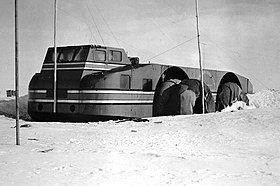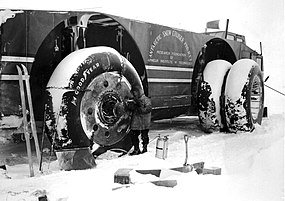Antarctic Snow Cruiser
The Antarctic Snow Cruiser was a vehicle designed from 1937 to 1939 under the direction of Thomas Poulter, intended to facilitate transport in Antarctica during the United States Antarctic Service Expedition (1939–41). The Snow Cruiser was also known as "The Penguin," "Penguin 1" or "Turtle"[1] in some published material.
| Antarctic Snow Cruiser | |
|---|---|
 The Antarctic Snow Cruiser, as it was abandoned (December 22, 1940) | |
| Overview | |
| Manufacturer | Armour Institute of Technology |
| Also called | The Penguin, Penguin 1, Turtle |
| Production | 1937-1939 |
| Model years | 1939 |
| Assembly | United States: Chicago, Illinois |
| Designer | Thomas Poulter |
| Body and chassis | |
| Class | Class 9 |
| Layout | Longitudinal front-engine, four-wheel drive |
| Powertrain | |
| Engine | Two 11.0 L (672 cu in) Cummins H-6 diesel engines |
| Electric motor | Four 56kW electric motors |
| Power output | 112 kW (152 PS) each |
| Dimensions | |
| Length | 669 in (17 m) |
| Width | 239 in (6 m) |
| Height | Wheels extended: 192 in (5 m) Wheels retracted: 144 in (4 m) |
| Curb weight | 75,000 lb (34,019 kg) |

Poulter had been second in command of Byrd's Second Antarctic Expedition, launched in 1934. From his time in the Antarctic, Poulter had devised several innovative features. However, the massive Snow Cruiser generally failed to operate as hoped under the difficult conditions (the tires, notably smooth to avoid becoming snow encrusted, would not grip the ice) and was eventually abandoned in Antarctica. Rediscovered under a deep layer of snow in 1958, it later disappeared again due to shifting ice conditions.
History
Design and construction
On April 29, 1939, Poulter and The Research Foundation of the Armour Institute of Technology showed the plans to officials in Washington, D.C.. The foundation would finance the cost and oversee the construction, and lend the vehicle to the United States Antarctic Service. Work began on August 8, 1939, and lasted for 11 weeks. On October 24, 1939, the vehicle was fired up for the first time at the Pullman Company just south of Chicago and began the 1,640 km (1,020 mi) journey to the Boston Army Wharf. During the trip, a damaged steering system caused the vehicle to drive off a small bridge on the Lincoln Highway and into a stream near the town of Gomer, Ohio, near Lima, Ohio, where it remained for three days. After it arrived in Boston, it departed for Antarctica on November 15, 1939, aboard the USCGC North Star.
Arrival in the Antarctic
The Snow Cruiser arrived at Little America in the Bay of Whales, Antarctica with United States Antarctic Service Expedition in early January 1940 and experienced many problems. It was necessary to construct a ramp from timber to unload the vehicle. As the vehicle was unloaded from the ship, one of the wheels broke through the ramp. The crew cheered when Poulter powered the vehicle free from the ramp but the cheers fell silent when the vehicle failed to move through the snow and ice. The large, smooth, treadless tires were originally designed for a large swamp vehicle; they spun freely and provided very little forward movement, sinking as much as 3 feet (0.91 m) into the snow. The crew attached the two spare tires to the front wheels of the vehicle and installed chains on the rear wheels, but were unable to overcome the lack of traction. The crew later found that the tires produced more traction when driven backwards. The longest trek was 92 miles (148 km) – driven completely in reverse. On January 24, 1940, Poulter returned to the United States, leaving F. Alton Wade in charge of a partial crew. The scientists conducted seismologic experiments, cosmic-ray measurements, and ice core sampling while living in the snow- and timber-covered Snow Cruiser. Funding for the project was canceled as the focus in the United States became World War II.
Rediscovery and final fate
During Operation Highjump in late 1946, an expedition team found the vehicle and discovered it needed only air in the tires and some servicing to make it operational. In 1958, an international expedition uncovered the snow cruiser using a bulldozer. It was covered by several feet of snow but a long bamboo pole marked its position. They were able to excavate to the bottom of the wheels and accurately measure the amount of snowfall since it was abandoned. Inside, the vehicle was exactly as the crew had left it, with papers, magazines, and cigarettes scattered all around.
Later expeditions reported no trace of the vehicle. Although there was some unsubstantiated speculation that the (traction-less) Snow Cruiser was taken by the Soviet Union during the Cold War, the vehicle most likely is either at the bottom of the Southern Ocean or buried deep under snow and ice. Antarctic ice is in constant motion and the ice shelf is constantly moving out to sea. In the mid-1960s, a large chunk of the Ross Ice Shelf broke off and drifted away; the break occurred right through Little America. It is not known on which side of the ice shelf the Snow Cruiser was located.
Vehicle details
| Attribute | Description |
|---|---|
| Length | 55 feet 9 inches (17.0 metres) |
| Width | 19 feet 11 inches (6.06 meters) |
| Height | Wheels retracted: 12 feet (3.7 meters) Wheels extended: 16 feet (4.9 meters) |
| Weight (loaded) | 75,000 lb (34,000 kg) |
| Range | 5,000 miles (8,000 km) |
| Maximum Speed | 30 mph (48 km/h) |
| Self-Sufficiency | 1 year under the most extreme conditions |
| Fuel Capacity | 2,500 US gallons (9,500 litres) stored under the floor |
| Additional Fuel Capacity | 1,000 US gallons (3,800 litres) stored on the roof, to be used by the plane |
| Crew Size | 5 people |
| Estimated Cost | $300,000 ($5.5 million today) |
| Cabin Compartments | control cabin, machine shop, combination kitchen/darkroom, fuel storage, food storage, two spare tires |
| Attribute | Description |
|---|---|
| Configuration | Diesel-Electric Hybrid (2 diesel engines, 2 generators, 4 electric motors) |
| Diesel Engine Manufacturer and Model | Cummins H-6 engine |
| Diesel Engine Power Rating | 150 horsepower (110 kW) @ 1800 rpm – 300 horsepower (220 kW) total combined power for 2 engines |
| Diesel Engine Configuration | 6-cylinder inline; naturally aspirated |
| Diesel Engine Displacement | 672 cubic inches (11.01 litres) |
| Diesel Engine Bore and Stroke | 4 7⁄8 in (120 mm) bore x 6 in (150 mm) stroke |
| Electric Generators | General Electric |
| Electric Drive Motor Manufacturer | General Electric |
| Electric Drive Motor Power Rating | 75 horsepower (56 kW) – 300 horsepower (220 kW) total combined power for 4 motors |
| Tire Manufacturer | Goodyear Tire and Rubber Company |
| Tire Dimensions | 120 in (3,000 mm) outer diameter x 66 in (1,700 mm) inner diameter x 33.5 in (850 mm) width |
Innovative features
Innovative features included:
- Wheels and tires retracted into housings where they were heated by engine exhaust gases. This was to prevent low-temperature cracking of the natural rubber compound.
- Long front and rear overhangs on the body were to assist with crossing crevasses up to 15 feet (4.6 m) wide. The front wheels were to be retracted so the front could be pushed across the crevasse. The front wheels were then to be extended (and the rear wheels retracted) to pull the vehicle the rest of the way across. This process required a complicated, 20-step procedure.
- A pad on top of the vehicle was designed to hold a small aircraft (a 5-passenger Beechcraft biplane). A winch would pull the aircraft into place. The plane was to be used to conduct aerial surveys.
- Engine coolant circulated through the entire cabin for heating. The heating system was very efficient and the crew reported that they needed only light blankets when sleeping.
- Excess electrical power could be stored in batteries for running lights and equipment when the engine was not running.
- The diesel-electric drive train allowed for smaller engines and more space for the crew, due to the elimination of large mechanical drive components throughout the vehicle. This is possibly the first application of a diesel-electric powertrain in a four-wheeled vehicle of this size; this design is now common in large modern mining trucks.
References
- "The Eagle & the Turtle" Archived March 14, 2009, at the Wayback Machine, Wings magazine. February, 1980.
External links
- LIFE Magazine (1939 October 30) article and cross-section of the Antarctic Snow Cruiser
- The Antarctic Snow Cruiser
- Snow cruiser history
- Reprint of article from Invention & Technology Magazine
- The Antarctic Edsel by Bob Hanes
- "Planting The Stars And Stripes In The Antarctic" from Popular Science